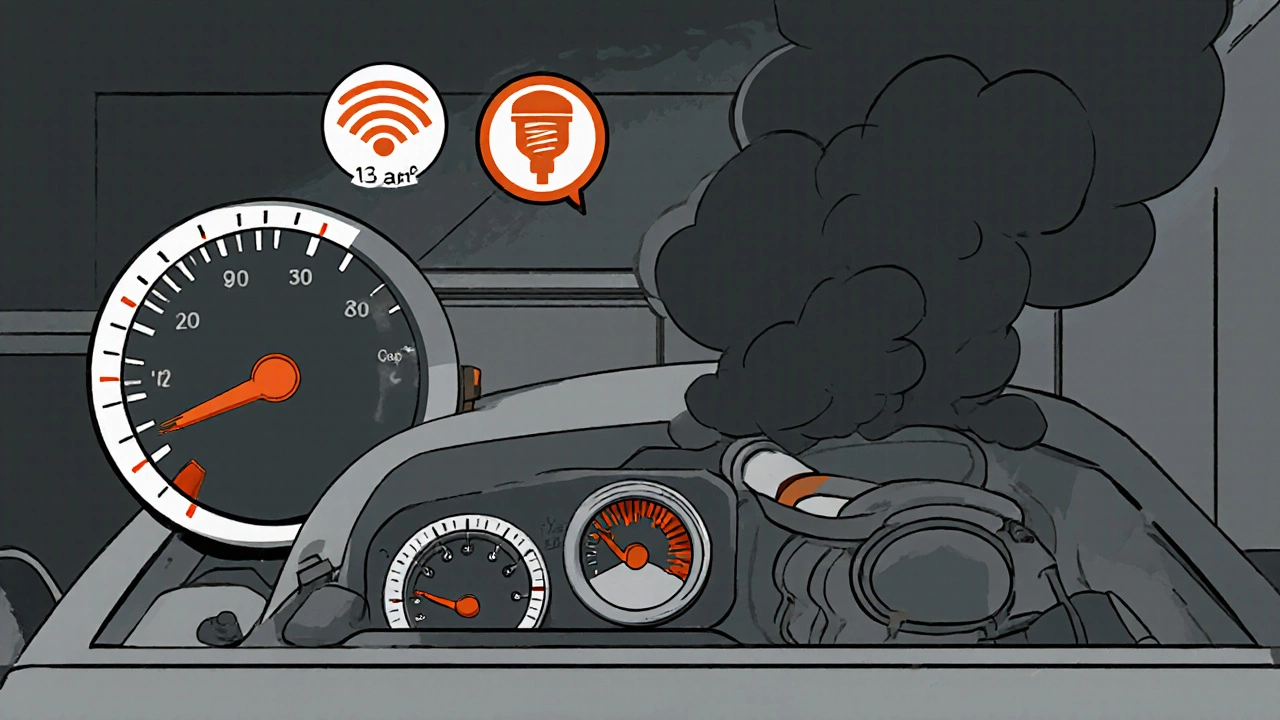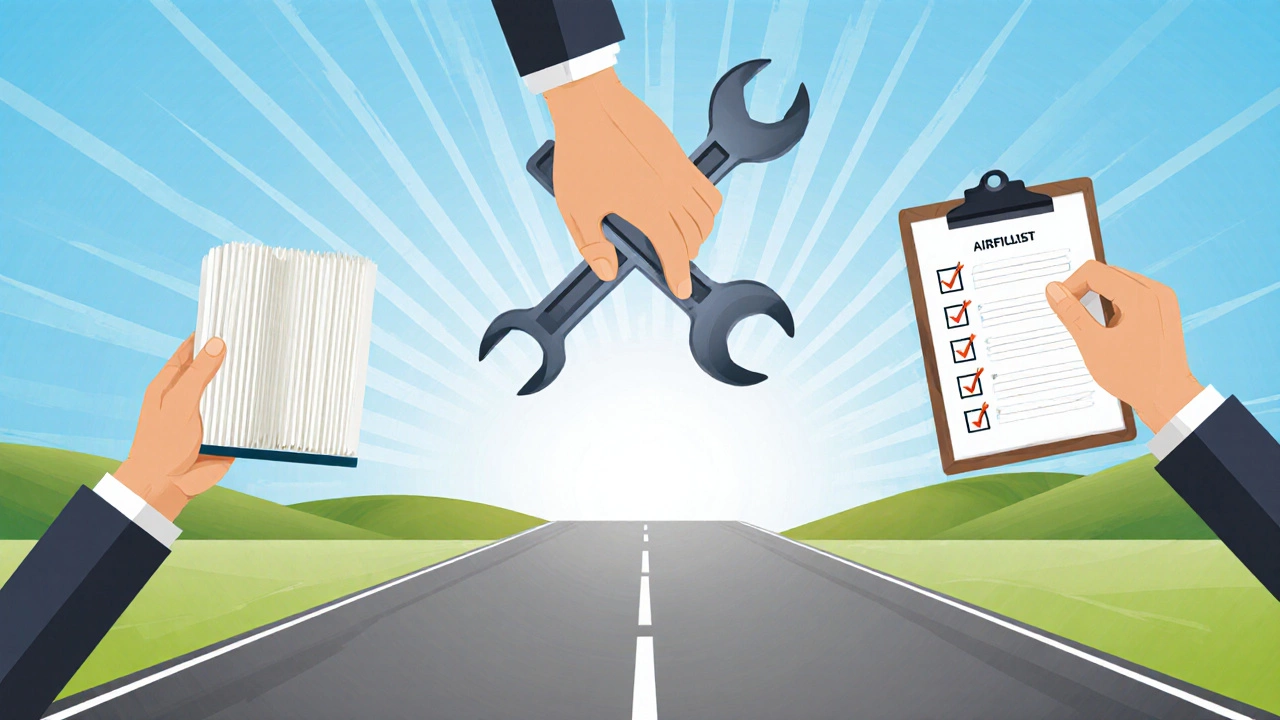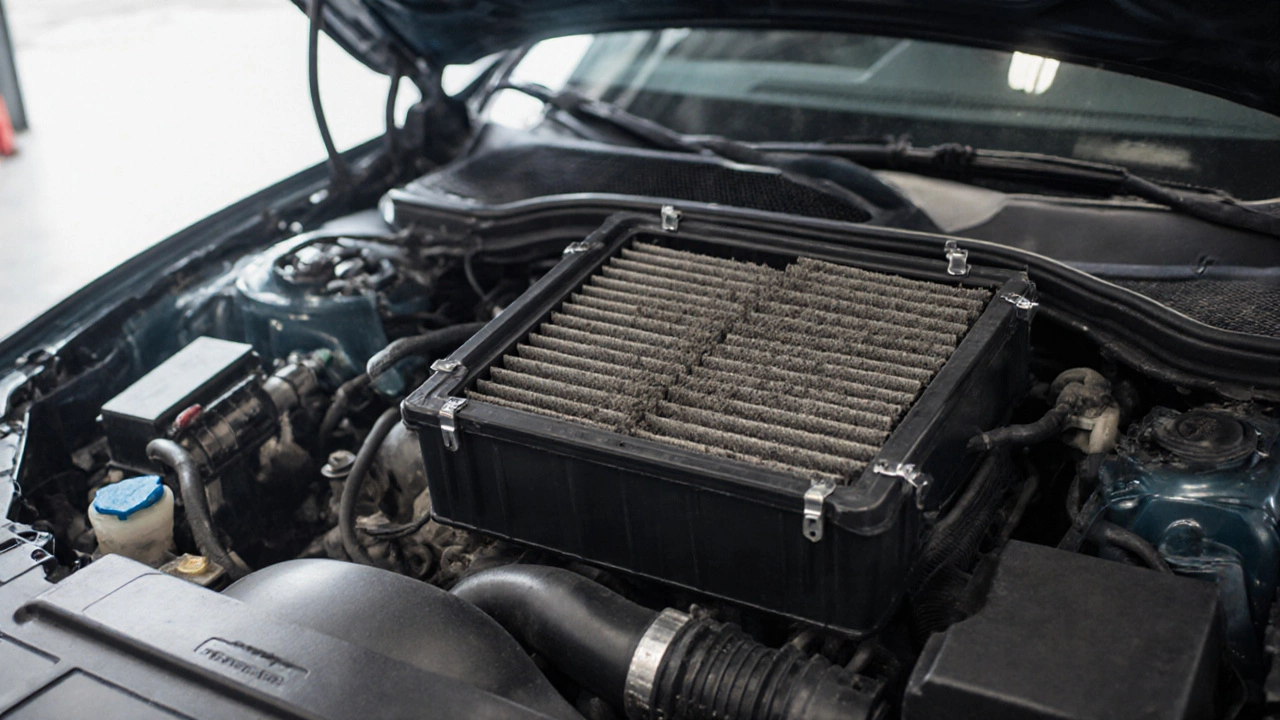Air Filter Diagnostic Tool
Symptoms Assessment
Check symptoms you're experiencing to identify potential air filter issues
When the air filter is a mesh or paper element that cleans the air before it enters your engine’s combustion chambers starts to choke, you’ll notice a handful of tell‑tale signs. Those bad air filter symptoms don’t just annoy you - they can sap mileage, crank up emissions, and even shorten the life of expensive engine parts.
Most drivers assume the air filter is a “set‑and‑forget” part, but dust, pollen, and even road‑salt grit pile up quickly, especially if you drive in rural or construction‑heavy areas. Knowing what to look for lets you replace the filter before the problem spirals into costly repairs.
How an Air Filter Works
The air filter captures dust, pollen, and other contaminants in a pleated media sits right between the intake manifold and the outside world. Clean air flows through the filter, while particles are trapped on the surface and inside the folds.
Your engine the heart of the vehicle that converts fuel and air into power relies on a precise air‑to‑fuel ratio. A clogged filter restricts airflow, forcing the engine’s computer to compensate by opening the throttle wider or enriching the mixture, both of which waste fuel and increase wear.
Modern engines equipped with fuel injection and sophisticated sensors can mask minor restrictions, but once the filter reaches a critical level of blockage, the symptoms become unmistakable.
Key Symptoms of a Bad Air Filter
- Reduced acceleration - You’ll feel a lag when you floor it. The engine can’t “breathe” fast enough, so power peaks lower than usual.
- Poor fuel economy - Expect anywhere from a 5 % to 15 % drop in miles per gallon. The engine consumes more fuel to compensate for the thin air flow.
- Rough idle - The car may shake or stall at a stop. A restricted filter throws off the air‑fuel mixture, making the idle unstable.
- Unusual engine noises - A whistling or sucking sound from the intake area often signals air struggling to pass through a clogged media.
- Increased exhaust smoke - Over‑rich combustion can produce darker, thicker exhaust, especially during warm‑up.
- Check Engine Light (CEL) - The onboard diagnostics may flag codes related to the oxygen sensor or fuel trim, both of which react to airflow problems.
Why Those Symptoms Matter
Each of the signs above points to a deeper issue in the fuel system delivers the right amount of gasoline to the combustion chambers. If the engine runs richer than needed, you’ll see:
- Higher fuel consumption (bad for your wallet).
- More carbon buildup on spark plugs and in the combustion chamber.
- Accelerated wear on the exhaust system directs burnt gases away from the engine and the catalytic converter reduces harmful emissions before they exit the tailpipe. A richer mix can overheat these components, shortening their lifespan.
- Potential fouling of the oxygen sensor measures exhaust oxygen levels to help the ECU adjust the air‑fuel ratio, which may trigger costly replacement if it’s constantly correcting a bad ratio.

Diagnosing a Bad Air Filter
Before you order a new filter, do a quick visual check. Most filters are located in a rectangular box under the hood, either beside the carburetor (older cars) or in the intake tube (modern engines).
- Turn off the engine and let it cool for a few minutes.
- Locate the filter housing; it’s typically secured with clips or a few bolts.
- Open the housing gently - many have a spring‑loaded latch that can be released by hand.
- Pull the filter out. Hold it up to a strong light source. If you can’t see through the pleats or the media looks dark and dusty, it’s time for a replacement.
- While the housing is open, inspect the intake manifold distributes fresh air to each cylinder for cracks or excessive oil buildup, which can also affect airflow.
- Re‑install a new filter, secure the housing, and clear any error codes with an OBD‑II scanner if the CEL remains on.
Fixing and Preventive Tips
- Replace on schedule - Most manufacturers recommend changing the filter every 12,000‑15,000 km, but dusty environments may need swaps as often as every 6,000 km.
- Use high‑flow filters wisely - Performance filters promise better breathing but can let larger particles through, requiring more frequent checks.
- Consider a reusable filter - Some aftermarket options let you wash and re‑oil the media. If you choose this route, follow the cleaning instructions exactly to avoid restricting flow.
- Check the cabin air filter - Though separate from the engine’s filter, a clogged cabin filter can reduce overall HVAC efficiency and cause a false sense of poor airflow.
- Combine with regular engine tune‑ups - Spark plug cleaning, fuel injector checks, and sensor calibrations keep the whole breathing system in sync.

Other Components That Can Mimic Bad Air Filter Symptoms
| Component | Shared Symptom | How to Differentiate |
|---|---|---|
| Fuel injector | Poor fuel economy | Check spray pattern; clogged injectors cause uneven fuel, not airflow restriction. |
| Oxygen sensor | Check Engine Light, rough idle | Sensor voltage readings stay out of spec even after fresh filter. |
| Ignition coil | Reduced acceleration | Misfire codes (P0300‑P030x) appear; filter replacement won’t help. |
| Vacuum leak | High idle, whistling noise | Listen for hissing with engine at idle; smoke test can locate leak. |
| Cabin air filter | Weak HVAC airflow | Affects interior climate, not engine performance. |
Quick Checklist for Bad Air Filter Detection
- Engine feels sluggish on acceleration?
- Mileage has dropped noticeably?
- Idle is rough or stalling?
- Unusual whistling noise from the intake?
- Check Engine Light with O2 sensor codes?
- Visual inspection shows dark or clogged filter media?
Bottom Line
Keeping the air filter clean and free of debris in good shape is one of the cheapest ways to protect engine health, save fuel, and stay compliant with emissions standards. A quick visual check and timely replacement can prevent a cascade of expensive repairs.
How often should I replace my car’s air filter?
Most manufacturers recommend a change every 12,000‑15,000 km, but if you drive on dusty roads, swap it every 6,000 km or check it visually each oil change.
Can a clogged air filter cause the Check Engine Light?
Yes. A severely restricted filter can lead to rich‑fuel conditions that trigger O₂ sensor or fuel‑trim codes, lighting the CEL.
Is it worth using a high‑performance air filter?
High‑flow filters can boost horsepower, but they let larger particles through, so you’ll need to inspect and clean them more often than paper filters.
Does a dirty cabin air filter affect engine performance?
No. The cabin filter only handles interior air. It can make the climate system feel weak, but it won’t change engine power or fuel economy.
What’s the difference between a paper and a foam air filter?
Paper filters are disposable and offer consistent flow restriction levels. Foam filters can be washed and reused, but they must be re‑oiled correctly to avoid severe airflow loss.

